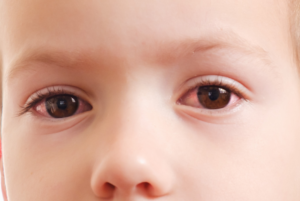Pinkeye (Conjunctivitis)
 Pink eye, also called conjunctivitis, is an irritation or infection of the conjunctiva, the thin, clear membrane that covers the inner surface of the eyelid and the white part of the eyeball (sclera).
Pink eye, also called conjunctivitis, is an irritation or infection of the conjunctiva, the thin, clear membrane that covers the inner surface of the eyelid and the white part of the eyeball (sclera).
This condition is extremely common and can be the result of irritants or a bacterial or viral infection.
What are the symptoms?
- The whites of the eyes are pink or red
- The eyelids may be swollen
- Scratchy, painful, or itchy red eyes
- Teary or watery eyes
- Pus or a thick discharge (yellow or yellowish-green colour) that can make eyelids sticky, especially during sleep
- Occasional light sensitivity
Method of spread
Pinkeye is highly contagious and can be spread by direct or indirect contact and droplet exposure. Direct exposure can occur when your child comes into contact with the virus directly when touching a discharge from a child infected with the virus or indirectly through touching items contaminated with discharge from the eye of an infected child.
Is pink eye contagious?
Pink eye is caused by a virus. It can be contagious from before symptoms start until they end. When drainage is present in the eye, the risk of spread increases. The virus can survive on surfaces for up to two weeks. It can take 1–3 days following contact with an infected person to know if you have contracted the virus.
If pink eye is caused by a bacterial infection, a child who has started treatment with antibiotics will not be contagious after 24 hours.
What you can do
- Teach your child to avoid touching their eyes with their hands
- Provide opportunities to wash hands thoroughly and frequently. Use a hand sanitizer if a sink is not available.
- Do not reuse tissues or clothes on your face; change pillowcases often.
- If you wear contacts, follow the recommended contact lens care.
If you suspect your child has pinkeye…
- Wipe tears or discharge from your child’s eye from the inside out and in one direction only. Use a clean part of the cloth each time.
- Wash your hands after touching or wiping your child’s eyes. Assist the child in keeping their hands clean.
- Don’t share towels or washcloths.
Consult your primary care provider if you think that you or your child needs treatment.
Talk to your doctor:
- If your baby has yellow-green eye discharge and is less than three months old.
- If the pinkeye seems to keep coming back
- If your child has a fever and is generally unwell, has a rash, or eye pain. Some more serious illnesses may look like pink eye at first.
How can I prevent the spread of pinkeye?
- Frequent hand washing. Wash your hands after touching your eyes or caring for a child’s eyes. Avoid touching your face.
- Avoid sharing personal items such as towels or facecloths.
- Frequent cleaning of surfaces that are commonly touched, such as door handles and toys.
- When cleaning discharge from your eyes, clean from the inside out and in one direction, using a clean part of the cloth for each wipe.
Services related to this information:
- Contact your Public Health Nurse.
- Contact your physician, nurse practitioner, or pharmacist.
- 811 HealthLine (Newfoundland & Labrador) – Call 811 or 1-888-709-2929 / TTY 1-888-709-3555

